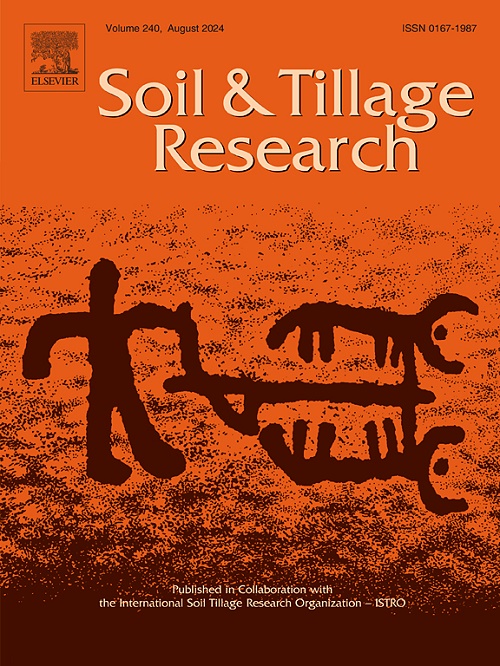Effects of soil porosity on water stability of aggregates
IF 6.1
1区 农林科学
Q1 SOIL SCIENCE
引用次数: 0
Abstract
Soil pore structure is a fundamental determinant of water infiltration, flow, and storage, and it is intricately linked to soil stability and erodibility. Understanding the interplay between soil pore structure and aggregate disintegration is vital for refining the erodibility factor in soil erosion prediction models. This study aimed to examine the differential impacts of pore volume on aggregate disintegration by employing three soil samples with controlled internal pore spaces at various initial moisture contents (air-dried aggregates with 3 %, 5 %, 10 %, 15 %, and 20 %). Computerized Tomography (CT) scanning technology was utilized to visualize and quantitatively assess the aggregate pore structure. The results indicated that the number of pores, as measured in three-dimensional (3D) space and fractal dimension (FD), initially increased and then subsequently decreased with rising moisture content. An increase in moisture content was associated with a decline in aggregate anisotropy values. The resistance of aggregates to slaking (RSI) diminished progressively with increasing moisture content. A significant negative correlation was observed between moisture content and anisotropy, mean weight diameter in the slow wetting (MWDsw), MWD in the pre-wetting followed by shaking (MWDws), and RSI. Conversely, anisotropy, MWDws, and RSI exhibited significant positive correlations. This study not only enhances our understanding of the relationship between soil pore structure and stability but also has substantial practical implications for predicting water infiltration, flow, and storage in soil during natural rainfall events, as well as for assessing the stability and erodibility of soil aggregates under varying humidity conditions and improving soil erosion prediction models.
土壤孔隙度对团聚体水稳定性的影响
土壤孔隙结构是水的渗透、流动和储存的基本决定因素,它与土壤的稳定性和可蚀性有着复杂的联系。了解土壤孔隙结构与团聚体崩解之间的相互作用,对于完善土壤侵蚀预测模型中的可蚀性因子具有重要意义。本研究旨在研究孔隙体积对团聚体崩解的不同影响,采用不同初始含水量(3 %、5 %、10 %、15 %和20 %的风干团聚体)的三种土壤样品,控制内部孔隙空间。利用计算机断层扫描技术对聚集体孔隙结构进行可视化和定量评价。结果表明,随着含水率的增加,孔隙的三维空间和分形维数呈先增加后减少的趋势;水分含量的增加与总各向异性值的下降有关。随着含水率的增加,骨料的抗滑脱性逐渐降低。水分含量与各向异性、慢润湿期平均重径、预润湿后摇摇期平均重径、RSI呈显著负相关。相反,各向异性、MWDws和RSI表现出显著的正相关。该研究不仅提高了我们对土壤孔隙结构与稳定性之间关系的认识,而且对于预测自然降雨过程中土壤水分的入渗、流动和储存,以及评估不同湿度条件下土壤团聚体的稳定性和可蚀性,改进土壤侵蚀预测模型具有重要的实际意义。
本文章由计算机程序翻译,如有差异,请以英文原文为准。
求助全文
约1分钟内获得全文
求助全文
来源期刊

Soil & Tillage Research
农林科学-土壤科学
CiteScore
13.00
自引率
6.20%
发文量
266
审稿时长
5 months
期刊介绍:
Soil & Tillage Research examines the physical, chemical and biological changes in the soil caused by tillage and field traffic. Manuscripts will be considered on aspects of soil science, physics, technology, mechanization and applied engineering for a sustainable balance among productivity, environmental quality and profitability. The following are examples of suitable topics within the scope of the journal of Soil and Tillage Research:
The agricultural and biosystems engineering associated with tillage (including no-tillage, reduced-tillage and direct drilling), irrigation and drainage, crops and crop rotations, fertilization, rehabilitation of mine spoils and processes used to modify soils. Soil change effects on establishment and yield of crops, growth of plants and roots, structure and erosion of soil, cycling of carbon and nutrients, greenhouse gas emissions, leaching, runoff and other processes that affect environmental quality. Characterization or modeling of tillage and field traffic responses, soil, climate, or topographic effects, soil deformation processes, tillage tools, traction devices, energy requirements, economics, surface and subsurface water quality effects, tillage effects on weed, pest and disease control, and their interactions.
 求助内容:
求助内容: 应助结果提醒方式:
应助结果提醒方式:


